Fed policymakers are lining up to oppose more interest-rate cuts

Three Federal Reserve policymakers voiced their resistance to the notion that the U.S. economy needs lower interest rates, and a fourth said he wants to avoid taking further action “unless we have to,” foreshadowing a sharp debate with officials who want to cut rates again.
Investors have fully priced in a quarter-percentage-point reduction at the Fed’s Sept. 17-18 policy meeting, but dissenting Fed voices may limit the prospects for the larger move that some — including President Trump — have advocated.
Chairman Jerome Powell could provide more guidance when he speaks Friday at the central bankers’ annual retreat in Jackson Hole, Wyo. This year the policy symposium will examine challenges facing monetary policy, a timely topic as officials weigh the appropriate policy response to slowing global economic growth and the risks of an escalating trade war.
“As I look at where the economy is, it’s not yet time, I’m not ready, to provide more accommodation to the economy without seeing an outlook that suggests the economy is getting weaker,” conference host and Kansas City Fed President Esther George told Bloomberg Television late Wednesday.
On Thursday, Philadelphia Fed chief Patrick Harker said he went along with the recent rate cut “somewhat reluctantly” and would like to hold rates steady for some time.
“We’re roughly where neutral is right now, and I think we should stay here for a while and see how things play out,” Harker said in an interview with CNBC television.
Later on Thursday, Dallas Fed President Robert Kaplan also sounded hesitant about cutting rates at the Fed’s September meeting.
“I’d like to avoid having to take further action, but I think I’m going to have an open mind about taking action over at least the next number of months if we need to,” he said in an interview with CNBC.
Boston Fed President Eric Rosengren also has voiced opposition to additional cuts, speaking in a Monday interview on Bloomberg TV.
George and Rosengren dissented against the Fed’s July 31 decision to cut interest rates — the central bank’s first rate cut since 2008.
Minutes of the July policy meeting, published Wednesday, revealed that Fed officials were split over the need to cut rates. The discussion pitted policy makers concerned about trade conflicts, slowing global growth and too-low inflation against those who saw strong U.S. economic data as an indication that businesses and consumers are powering through the latest uncertainties. The minutes said “several” officials favored keeping rates on hold, making clear the opposition went beyond George and Rosengren.
“Easing policy is not a free choice,” George said. “It, remember, pulls forward demand. It can make leverage more attractive. And I think, depending on where you think you are in the business cycle, it can create more risk.”
Like Rosengren and Harker, George said the U.S. economy was slowing but still appeared to be in good shape.
“When I look at where unemployment is and I look at where inflation is right now, I think we’re in a good place as long as the consumer can continue to pull the economy forward,” George said. “Obviously, we have some weaker segments in our economy, but to the extent that our forecast of growing at around 2% holds, then I think we’re OK.”
Financial markets have been volatile in recent weeks amid unfavorable news about economic weakness overseas and renewed trade tensions between the Trump administration and China. Data released Thursday showed U.S. factory orders in August contracted for the first time since September 2009.
“Markets see how the rest of the world is slowing. I think uncertainty never plays well in the markets,” George said. “So, I understand why you see fear and uncertainty right now. That isn’t the metric, though, that I feel we have to focus on. We have a clear mandate and, I think, a long-term view that we have to stay focused on.”
More to Read
Inside the business of entertainment
The Wide Shot brings you news, analysis and insights on everything from streaming wars to production — and what it all means for the future.
You may occasionally receive promotional content from the Los Angeles Times.










